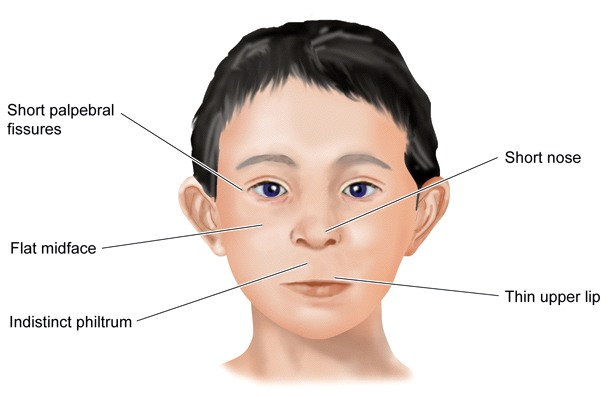 |
| Several small studies have suggested children with FASD may be at an increased risk of various refractive and ocular conditions. A more recent, large study identified strabismus as a potential visual outcome of the disorder, but only in those with partial fetal alcohol syndrome. Photo: Duke University. Click image to enlarge. |
Fetuses don’t yet have a functioning alcohol elimination system, which is why alcohol exposure during gestation can lead to a whole host of abnormalities throughout the body. Babies and children who develop health problems from alcohol exposure in utero are described as having fetal alcohol spectrum disorders (FASDs). Evidence suggests that the eye is not spared from potential harm; prior research has found that alcohol exposure during pregnancy may result in reduced visual acuity, refractive errors, strabismus, anomalies of the anterior segment and malformations of the retina and optic nerve.
Because most previous studies had limited sample sizes, researchers recently conducted a larger study to further investigate their findings. They were able to identify a significant association between FASD and strabismus, but not between FASD and any other vision outcomes.
The cross-sectional, observational study included a total of 424 five- to seven-year-olds from 30 participating schools. These were the eligible students who remained from an original pool of 4,625 children. Each child underwent a comprehensive assessment including neurobehavioral testing, maternal interviews, dysmorphology examination and reports from teachers to assess behavioral functioning in school. Ophthalmic data from medical records were also collected and evaluated (including vision screenings completed by a school nurse, ophthalmologist or pediatrician).
Of the 424 participants, 8% were determined to have FASD. The percentage of children with strabismus was significantly greater in the group of children with FASD (5/42, 11.9%) vs. the group without the disorder (6/290, 2.1%). Contrary to prior studies, no association was found between FASD and vision impairment, refractive errors, glasses/contact lens prescription or having one or more ophthalmological abnormalities.
One finding from the present study that is consistent with prior investigations is that all five children with FASD and strabismus had partial fetal alcohol syndrome, translating to a 26.3% strabismus prevalence among children with this form of FASD. Partial fetal alcohol syndrome distinguishes itself from other conditions on the FASD spectrum by referring to children who only have two of the physical aspects of fetal alcohol syndrome.
In contrast, no cases of strabismus were detected in the 22 children with another type of FASD known as alcohol-related neurodevelopmental disorder, which is characterized by the absence of facial abnormalities. In their paper on the study, the researchers note that this finding “suggests that the effect of prenatal alcohol exposure in order to produce strabismus must be severe enough to result in facial abnormalities of FASD that are seen in partial fetal alcohol syndrome.”
The study authors conclude that “since FASD is a potentially preventable condition, it is important to increase public awareness as we deepen our understanding of the consequences of prenatal alcohol exposure. Clinicians examining children with FASD or prenatal alcohol exposure should always screen for eye disease and refer for additional examination when necessary.”
Lyubasyuk V, Jones KL, Caesar MA, Chambers C. Vision outcomes in children with fetal alcohol spectrum disorders. Birth Defects Research. July 17, 2023. [Epub ahead of print]. |

